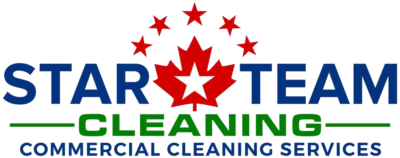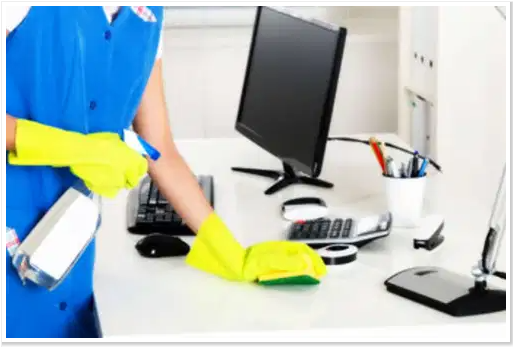Clean and Disinfect your Workplace in Pandemic
Routine cleaning and disinfection practices play a critical role in minimizing the spread of a number of infectious diseases. The COVID-19 pandemic has demonstrated the importance of cleaning and disinfecting in the public and commercial sectors. Hand washing, social distancing and regular cleaning of surfaces can help slow the spread of the virus.
Taking a similar approach in future pandemics can help keep businesses up and running while protecting employees and clients or customers. Star Team Cleaning can assist with your commercial cleaning and disinfecting needs.
Why Preventative Cleaning is Important During a Pandemic
In the event of a pandemic, preventative cleaning and disinfecting from Star Team Cleaning can do two things:
- Help slow or stop the spread of disease
- Make employees, clients and customers feel safe
Cleaning and disinfecting can be an effective way to slow or stop the spread of illness. For businesses, this is crucial because absenteeism can bring productivity to a grinding halt. Furthermore, failure to take steps to address the spread of illness can make employees feel unsafe in the workplace.
Preventative cleaning can help maintain productivity while boosting morale and trust among employees.
In the case of COVID-19, the data is still unclear as to whether the virus can be transmitted from surfaces or not. Nevertheless, cleaning and disinfecting surfaces on a regular basis makes staff and clients feel more comfortable.
For businesses that regularly meet with clients or have customers enter the premises, regular disinfection will show that you care about the safety of your workers and visitors. Ultimately, this can help build trust and a positive reputation in the community.
Developing a Plan for Preventative Cleaning and Disinfection
The importance of cleaning and disinfecting is clear, but businesses must have a plan. Start by evaluating your environment and the surfaces within it.
Most hard surfaces will only require regular routine cleaning, but high-touch surfaces like doorknobs and switches should be cleaned and disinfected to reduce the risk of spreading illness.
If the environment has soft or porous materials, such as rugs and chairs, it may be worth considering storing or moving these items until after the pandemic passes. This will eliminate the challenges of cleaning these items. If these items are essential, professional cleaning services can ensure proper cleaning and disinfecting of these surfaces.
Create a List of Items to be Cleaned
First, it’s important to figure out which items need to be cleaned. Many surfaces can simply be cleaned with soap and water. Surfaces that are touched infrequently may only need regular cleaning without disinfection.
Disinfectants should never be applied to items used by children, especially items they may put in their mouths.
When determining what needs to be cleaned, there are a few things to consider:
- Is it an outdoor area? Outdoor areas only need regular, routine cleaning. Disinfection is normally not required. However, it is important to check with current guidelines or regulations to ensure that outdoor surfaces are clean.
- When was the space last occupied? If your business or certain areas of your facility have been shut down for seven days, routine cleaning may be all that’s necessary. Germs can only live on a surface for a certain period of time, so additional disinfecting measures may not be necessary.
Create a List of Items That Need to be Disinfected
Some surfaces will only need regular cleaning, but others will require the additional step of disinfecting. Generally, high-touch surfaces will need to be disinfected because they are used so often and may easily spread germs.
Developing a plan can be complicated. At Star Team Cleaning, we can help you with this difficult task. We have expertise in this area, so we can confidently help you develop a plan for preventative cleaning.
Implementing Your Plan and Revise as Necessary
Once you have a plan in place, it’s important to implement it. If you’re using a professional cleaning service, very little work will be needed on your part. They will review and implement your plan accordingly.
Otherwise, you will need to train your staff on how to follow the plan and make sure that staff is following instructions accordingly.
Over time, you may need to revise your plan based on new research, data or the effectiveness of your current plan.
It’s important to keep in mind that routine, normal cleaning with soap and water can go a long way in slowing or preventing the spread of illness as well as exposure.
7 Tips for Deep Cleaning and Disinfecting
1. Use the Right Gear and Cleaners
Preparation is just as important as the cleaning process. When preventative cleaning is performed during a pandemic, steps must be taken to prevent transmission and exposure to harsh chemicals. This means:
- Training on how to use cleaning and disinfection chemicals properly.
- Wearing disposable gloves and gowns throughout the entire cleaning process and when handling trash.
- Washing hands regularly with soap and warm water for 20 seconds. Hand sanitizer with 60% alcohol may be used if soap and water are not available.
2. Focus on Key Areas First
When cleaning and disinfecting surfaces, it’s important to focus on key areas, such as high touch surfaces. The frequency of cleaning and disinfection will depend on the level of use.
For objects and surfaces in public places, cleaning and disinfection should take place before each use.
High-touch surfaces include but are not limited to:
- Doorknobs
- Tables
- Chairs
- Light switches
- Toilets
- Faucets
- Sinks
- Handles
- Phones
- Keyboards
- Desks
Having a plan for frequency of cleaning and disinfecting is important for preventing transmission of viruses and bacteria. The frequency will depend on the level of use for each item or surface and how the item or surface is used.
For example, shopping carts should be wiped down and disinfected before every use. Keyboards, although used frequently, may only need to be disinfected once a day if the same person is using the keyboard all day.
High-touch surfaces should be cleaned and disinfected at least once daily. More frequent cleanings may be required when items are used heavily throughout the day. Its very critical to stop/prevent the spread of illness/virus/diseases by Disinfecting and sanitizing all surfaces properly. That’s why we have implemented Electrostatic disinfectant spraying system.
3. Clean and Then Disinfect
For thorough disinfection, it’s important to clean first and then disinfect. Soap and water will reduce germs and impurities. Disinfectants will kill the germs.
Skipping either step can leave germs behind that may potentially lead to transmission.
4. Use the Appropriate Disinfectants
The Centers for Disease Control and Prevention (CDC) recommends using an EPA-registered household disinfectant for the disinfecting stage.
It is crucial to follow the instructions on the label to ensure safety and effectiveness.
- Some disinfectants must sit on a surface for a certain period of time to ensure that all germs are killed.
- Safety precautions must be taken, such as wearing gloves and making sure there is adequate ventilation.
- Never mix chemical solutions.
- Unless otherwise stated on the product label, always use room temperature water when diluting disinfectants.
Household bleach is an effective disinfectant. The CDC recommends making a bleach solution consisting of:
- 5 tbsp. bleach per gallon of water (room temperature), OR
- 4 tsp. bleach per quart of water (room temperature)
If you can’t use bleach or another EPA-registered disinfectant, cleaning solutions with at least 70% alcohol can be used.
5. Clean Soft Surfaces Carefully
Soft surfaces, such as sofas, carpets, rugs and curtains, can be challenging to disinfect with conventional cleaning and disinfecting products.
Most soft surfaces can be cleaned with regular soap and water to reduce germs, or you may use appropriate cleaning products for the fabric or material that needs to be disinfected.
If possible, launder soft items like curtains and small rugs. Wash these items on the warmest temperature that’s appropriate for the material and dry thoroughly before use.
If it’s not possible to launder the item, you may try using a disinfectant that is appropriate for the material.
Finish up by vacuuming to remove any remaining dirt, debris or germs.
6. Don’t Forget to Clean Electronics
Electronics are often overlooked in the cleaning and disinfecting process, but many of these devices are high-touch surfaces that may spread illness.
Tablets, touchscreens, smartphones, remote controls and keyboards are all used and touched on a regular basis – often many times throughout the day.
To clean and disinfect electronics, the CDC recommends using sprays or wipes that contain at least 70% alcohol. Make sure that all surfaces are thoroughly dry before use.
If possible, use wipeable covers to make cleaning even easier.
7. Implement Practices to Reduce Exposure Risk
Along with professional cleaning, it’s important to implement certain practices to reduce risk exposure, such as having staff:
- Wipe down surfaces before and after they are touched.
- Wash hands regularly, particularly after touching heavily used surfaces.
- Avoid touching their face, especially after handling a high-touch surface.
- Use of masks and gloves properly to protect others.
- Avoid hand shaking.
- Practice social distancing.
Implementing these practices will complement cleaning and disinfecting procedures by further stopping the spread of illness. But they can only be effective if everyone is on board and adopting them.
Final Thoughts
Professional preventative cleaning and disinfecting can help slow or stop the spread of illness in the event of a pandemic. While commercial businesses can tackle this monumental task themselves, it’s often more cost-effective to hire a commercial cleaning service with expertise in proper disinfecting procedures. That’s where we come in. Star Team Cleaning can handle all of your preventative cleaning and disinfecting needs.


